Top Ten Most Beautiful Mollusks
Mollusks (or molluscs) are invertebrates from the phyllum Mollusca. Mollusks are very diverse in sizes, shapes, behaviour, and habitat. The phyllum Mollusca consists to 9 or 10 classes, 2 are extinctMollusks are interesting animals. Some mollusks look magneficent, and here are some of them
 Glaucus atlanticus is a species of small, blue sea slug, a pelagic aeolid nudibranch, a shell-less gastropod mollusk in the family Glaucidae.
Glaucus atlanticus is a species of small, blue sea slug, a pelagic aeolid nudibranch, a shell-less gastropod mollusk in the family Glaucidae. Glaucus atlanticus (or the common name blue dragon, and many other common names) is a rare species of sea slug found throughout the world's oceans
The famous blue dragon sea slug. Looks like something that would come from the Pokemon world, right? It's very beautiful, but be careful because it can sting. It feeds on Portuguese man o' wars and it absorbs its prey's venom, so its sting would be similar to a Portuguese man o' war's
Wow it eats man o' wars and absorbs their venom? That's bad A! And it's a beautiful, brilliant blue!
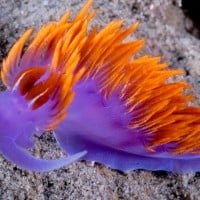
Spanish shawl (Flabellina iodinea) is a species of aeoloid nudibranch (sea slug) native to the west coast of North America
It has stunningly beautiful colors. Purple body, orange cerata (the long structures coming out of the back), scarlet rhinopores, and orange gills. The stunning colors of this sea slug is actually a warning to predators, telling them that it's venomous or distasteful
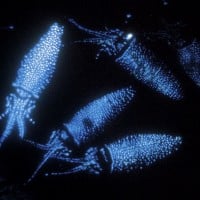 A bioluminescent cephalopod found in the western Pacific Ocean, the Firefly Squid uses its light-producing abilities for camouflage and communication. It is most commonly observed during its spawning season, when it gathers in large numbers.
A bioluminescent cephalopod found in the western Pacific Ocean, the Firefly Squid uses its light-producing abilities for camouflage and communication. It is most commonly observed during its spawning season, when it gathers in large numbers. Firefly squid (Watasenia scintillans) is a small species of squid found in Japan
It has one of the most beautiful abilities an organism could have: bioluminescence. It mostly stays in the deep parts of the seas at day, but it comes out to the surface at night to hunt, and its bioluminescence makes the sea "glow"
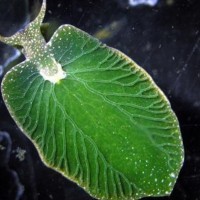
Eastern emerald elysia (Elysia chlorotica) is a species of sea slug found in the east coast of United States
It's light green and looks very similar to a leaf. It's one of the sea slugs that have the ability to photosynthesis, an ability usually only plants can do. How does it do it? It gets chlorophyll, which is essential for photosynthesis, from the algae it feeds on. That's also how it got its light green color, which is used for camouflage
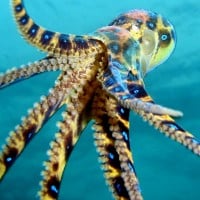 The Blue Ringed Octopuses (Hapalochlaena) are the four strongly venomous species that are found on the coral reefs and tidal pools in the Pacific and Indian Ocean, particularly from Australia to Japan. It is known as one of the most poisonous and deadliest sea creatures. It can kill a human body by... read more
The Blue Ringed Octopuses (Hapalochlaena) are the four strongly venomous species that are found on the coral reefs and tidal pools in the Pacific and Indian Ocean, particularly from Australia to Japan. It is known as one of the most poisonous and deadliest sea creatures. It can kill a human body by... read more Blue-ringed octopus (Hapalochlaena) is an octopus living in tide pools and coral reefs in the Pacific and Indian Oceans, from Japan to Australia
When calm, it looks like an ordinary octopus, but when it feels threatened, blue rings will appear on its body. It's beautiful when it does that, but it's actually a warning because this octopus is one of the most venomous marine animals
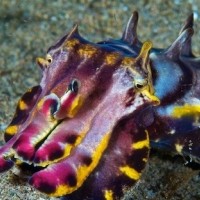
Pfeffer's flamboyant cuttlefish (Metasepia pfefferi) is a species of cuttlefish found in tropical Indo-Pacific waters
It's an unusually colorful cuttlefish, and is beautiful, but the colors is actually a warning. The flesh contains some kind of acid, which makes it unconsumable
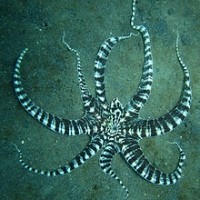 The mimic octopus is an Indo-Pacific species of octopus capable of impersonating other local species.
The mimic octopus is an Indo-Pacific species of octopus capable of impersonating other local species. Mimic octopus (Thaumoctopus mimicus) is a small species of octopus found in Indo-Pacific waters
The normal color of this octopus is light brown or beige, but when threatened, it changes its color to white and brown stripes. Not only that it's beautiful, it's unique too. Its mimicry ability is really advanced: It can even mimic other animals
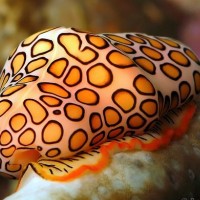
Flamingo tongue snail (Cyphoma gibbosum) is a small species of sea snail found in the tropical waters of the western Atlantic Ocean.
Its "shell" is bright orange-yellow with black markings, but well, I put quotation marks on the word "shell" for a reason. It's not really the shell that's colorful, it's the live mantle tissues that covers the shell that's colorful. The tissues can be retracted to expose the shell.
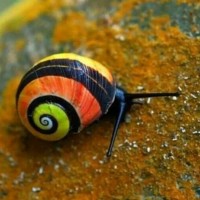
Also known as the painted snail. Cuban land snail (Polymita picta) is a large species of land snail endemic to Cuba
The shell of this snail is shiny and bright colored. There are lots of color varieties. Because of its beauty, this snail is often used for jewelry and trinkets, making it endangered.
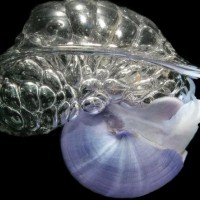
Also known as violet sea snail. Common violet snail (Janthina janthina) is a species of sea snail found worldwide in warm tropical waters.
The shell has light purple shade on the spire and darker purple on the ventral side. It has a bubble raft, a feature that allows it to float on the surface.